Click on images to enlarge
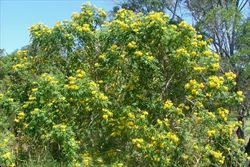
habit in flower (Photo: Sheldon Navie)
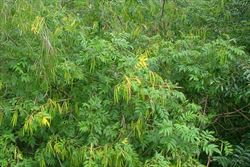
habit with immature fruit (Photo: Sheldon Navie)
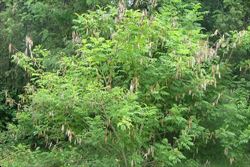
habit with mature fruit (Photo: Sheldon Navie)
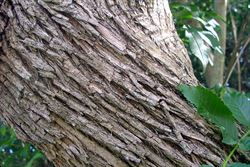
rough bark on trunk of mature tree (Photo: Sheldon Navie)
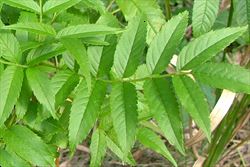
once-compound leaf with toothed leaflets (Photo: Sheldon Navie)
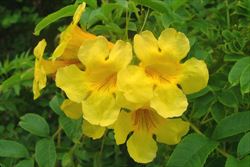
flowers (Photo: Sheldon Navie)
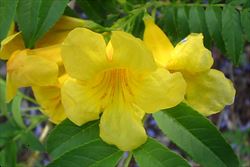
close-up of flower with reddish lines in the throat (Photo: Sheldon Navie)
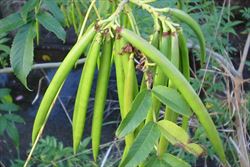
immature fruit (Photo: Sheldon Navie)
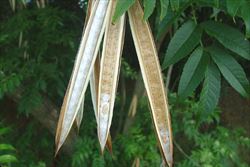
mature fruit with seeds (Photo: Sheldon Navie)
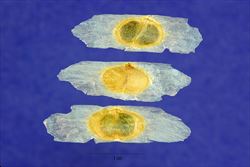
close-up of seeds (Photo: Steve Hurst at USDA PLANTS Database)
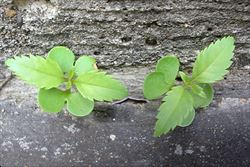
seedlings (Photo: Sheldon Navie)
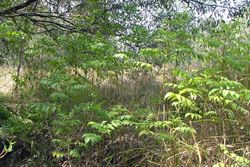
young saplings (Photo: Sheldon Navie)
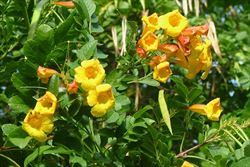
Orange bells,Tecoma alata, which is often confused with yellow bells, Tecoma stans (Photo: Sheldon Navie)

close-up of the flowers of orange bells (Tecoma alata), with reddish-orange outer surfaces and yellow throats without any reddish lines (Photo: Mellisa Offord)
Scientific Name
Tecoma stans (L.) Kunth
Synonyms
Bignonia stans L.Stenolobium stans (L.) Seem.Tecoma stans (L.) Kunth var. stansTecoma stans (L.) Kunth var. velutina DC.
Family
Bignoniaceae
Common Names
ginger-thomas, tecoma, trumpet flower, trumpetbush, yellow bells, yellow elder, yellow trumpet bush, yellow trumpet flower, yellow trumpet flowers, yellow trumpetbush, yellowbells, yellow-elder
Origin
Native to the tropical Americas (i.e. southern USA, Mexico, the Caribbean, Peru and Ecuador).
Cultivation
Yellow bells (Tecoma stans) has been widely cultivated as a garden ornamental, particularly in the warmer parts of Australia.
Naturalised Distribution
Widely naturalised in the coastal districts of northern and eastern Australia (i.e. in northern and eastern Queensland, eastern New South Wales and northern and north-western Western Australia). Possibly also naturalised in the Northern Territory and naturalised on Christmas Island.
Habitat
A a weed of roadsides, waterways (i.e. riparian areas), open woodlands, grasslands, forest margins, waste areas and disturbed sites in tropical and sub-tropical environments.
Habit
A large shrub or small, much-branched, tree usually growing 1.5 to 5 m tall, but occasionally reaching up to 10 m in height.
Distinguishing Features
- a shrub or small tree with once-compound paired leaves.
- its leaves have several elongated leaflets with sharply toothed margins.
- it produces small clusters of showy, yellow, tubular flowers (30-50 mm long) with five rounded lobes and several faint reddish lines in their throats.
- its fruit are large elongated capsules (10-30 cm long and 5-20 mm wide) that split open to release numerous papery seeds.
- its seeds (7-8 mm long and about 4 mm wide) have a transparent wing at each end.
Stems and Leaves
The younger stems are smooth, hairless (i.e. glabrous) and greenish in colour. They are slightly four-angled in cross-section (i.e. quadrangular) and turn pale brown or reddish-brown in colour as they age. The bark on the main stem is light brown to pale grey in colour, furrowed, and relatively rough in texture.
The leaves (10-25 cm long) are arranged in pairs (i.e. oppositely arranged) and are borne on slender stalks (i.e. petioles) 1-9 cm long. They are compound (i.e. pinnate) with 3-13 leaflets, but usually have 3-7 leaflets. The leaflets are narrowly egg-shaped (i.e. ovate-lanceolate) or elongated in shape (25-100 mm long and 8-30 mm wide) and have a pointed tip (i.e. acuminate apex). Their margins are irregularly and sharply toothed (i.e. serrated) and they are mostly hairless (i.e. glabrous), though a few hairs may be present on their undersides near the midrib.
Flowers and Fruit
The showy flowers are borne in several-flowered clusters (5-15 cm long) that are first produced at the ends of the branches (i.e. in terminal clusters), and then later in the leaf forks (i.e. axils) near the tips of the branches (i.e. in axillary clusters). These flowers are bright yellow in colour, tubular in shape, and borne on short stalks (i.e. pedicels) that are somewhat curved or twisted. The flower tube (i.e. corolla tube) is 30-50 mm long and has five rounded lobes that are 8-30 mm long. There are several faint reddish lines in the throat of the flower, which is slightly ridged and hairy. Flowering occurs mostly during spring, but may also be apparent throughout the year.
The fruit are large, elongated (i.e. linear), and somewhat flattened (i.e. compressed) capsules (10-30 cm long and 5-20 mm wide). These fruit turn from green to brown in colour as they mature and finally split open to release numerous papery seeds.
The seeds are very flat, oblong in shape (7-8 mm long and about 4 mm wide), and have a transparent wing at each end (the size of entire seed including the wings is about 20 x 6 mm).
Reproduction and Dispersal
This plant produces numerous light and papery seeds that are primarily wind-dispersed. They may also be spread by flood waters and in dumped garden waste.
Environmental Impact
Yellow bells (Tecoma stans) is regarded as an environmental weed in Queensland and New South Wales, and as a minor or potential environmental weed in the Northern Territory and Western Australia.
Legislation
This species is declared under legislation in the following states and territories:
- New South Wales: Class 3 - a regionally controlled weed. The relevant local control authority must be promptly notified of the presence of this weed and it must be fully and continuously suppressed and destroyed (in the Ballina, Bellingen, Byron, Clarence Valley, Coffs Harbour, Kyogle, Lismore, Nambucca, Richmond Valley and Tweed local authority areas).
- Queensland: Class 3 - this species is primarily an environmental weed and a pest control notice may be issued for land that is, or is adjacent to, an environmentally significant area (throughout the entire state). It is also illegal to sell a declared plant or its seed in this state.
- Western Australia: Unassessed - this species is declared in other states or territories and is prohibited until assessed via a weed risk assessment (throughout the entire state).
Similar Species
Yellow bells (Tecoma stans) is very similar to orange bells (Tecoma alata) and may also be confused with the garden plants known as golden trumpet vine (Allamanda cathartica) and shrubby allamanda (Allamanda schottii). It may occasionally also be confused with yellow oleander (Cascabela thevetia). These species can be distinguished by the following differences:
- yellow bells (Tecoma stans) has compound (i.e. pinnate) leaves that are oppositely arranged along the stems. These leaves have several toothed (i.e. serrated) leaflets and are borne on long slender stalks (i.e. petioles). Its moderately large (3-5 cm across) tubular flowers are almost entirely yellow in colour. Its fruit are long and narrow capsules (10-30 cm long) that split open when mature to release numerous papery seeds.
- orange bells (Tecoma alata) has compound (i.e. pinnate) leaves that are oppositely arranged along the stems. These leaves have several toothed (i.e. serrated) leaflets and are borne on long slender stalks (i.e. petioles). Its moderately large (3-5 cm across) tubular flowers have reddish-orange outsides. Its its fruit are long and narrow capsules (10-30 cm long) that split open when mature to release numerous papery seeds.
- golden trumpet vine (Allamanda cathartica) has simple leaves that are clustered (i.e. whorled) along the stems. These leaves have entire margins and are borne on short stalks (i.e. petioles). Its flowers are very large (6-15 cm across) and its fruit are rounded and prickly (4-6 cm long) capsules that split open when mature to release numerous winged seeds.
- shrubby allamanda (Allamanda schottii) has simple leaves that are clustered (i.e. whorled) along the stems. These leaves have entire margins and are borne on short stalks (i.e. petioles). Its flowers are moderately large (3-6 cm across) and its fruit are rounded and prickly (4-6 cm long) capsules that split open when mature to release numerous winged seeds.
- yellow oleander (Cascabela thevetia) has simple leaves that are spirally arranged (densely alternately arranged) along the stems. These leaves are long and narrow (i.e. linear) with entire margins and obscure stalks (i.e. petioles). Its flowers are moderately large (4-6 cm across) and its fruit are large fleshy drupes (25-55 mm across) that are somewhat rounded or slightly triangular in shape.

